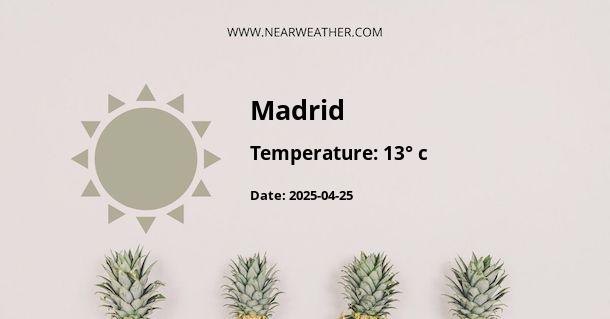Madrid, CO: Climate and Weather Overview
Madrid, the capital city of Spain, experiences a Mediterranean climate, characterized by hot, dry summers and mild, wet winters. Located in the heart of the Iberian Peninsula, Madrid's climate is influenced by its inland location, with some continental characteristics. Understanding the year-round weather patterns in Madrid is crucial for residents and tourists alike, as it provides valuable insight into what to expect and how to prepare for various activities and events throughout the year.
Madrid, CO: Annual Weather Summary
The following table provides an overview of the average weather conditions in Madrid throughout the year:
| Month | Average High (°F) | Average Low (°F) | Average Precipitation (in) |
|---|---|---|---|
| January | 50 | 32 | 1.3 |
| February | 54 | 34 | 1.3 |
| March | 59 | 37 | 1.6 |
| April | 64 | 41 | 1.8 |
| May | 72 | 48 | 2.3 |
| June | 82 | 57 | 1.6 |
| July | 90 | 64 | 0.5 |
| August | 89 | 64 | 0.4 |
| September | 81 | 59 | 1.3 |
| October | 70 | 50 | 2.3 |
| November | 58 | 41 | 1.8 |
| December | 51 | 34 | 1.4 |
As demonstrated in the table, Madrid experiences significant temperature variations throughout the year. Summers are hot, with average highs peaking at 90°F in July, while winters are relatively mild, with average lows reaching 32°F in January. The city also experiences moderate precipitation, with the wettest months typically occurring in spring and autumn.
Madrid, CO: Seasonal Weather Patterns
Spring (March - May)
Spring in Madrid brings mild temperatures and an increase in precipitation. Average highs range from 59°F in March to 72°F in May, making it an ideal time to explore the city's outdoor attractions. However, visitors should be prepared for occasional rain showers during this season.
Summer (June - August)
Summer heralds the arrival of hot and dry weather in Madrid. With average highs reaching up to 82°F in June and peaking at 90°F in July, it's essential to take precautions against the heat when visiting during this time. The low precipitation levels make summer the perfect season for outdoor activities and festivities.
Autumn (September - November)
Autumn sees a gradual decrease in temperatures and an increase in precipitation. The average highs range from 81°F in September to 58°F in November, accompanied by moderate rainfall. This season offers a pleasant climate for exploring the city while enjoying the changing colors of the foliage.
Winter (December - February)
Winter in Madrid is characterized by mild temperatures and cool, crisp days. Average highs range from 51°F in December to 54°F in February, with occasional frosty nights. While snow is rare, visitors should be prepared for colder weather and some rainfall during this season.
Climate Considerations for Visitors
When planning a trip to Madrid, it's essential to consider the climate and weather conditions to ensure a comfortable and enjoyable experience. Whether visiting for sightseeing, outdoor activities, or cultural events, understanding the seasonal variations in temperature and precipitation can help travelers make informed decisions about what to pack and what activities to prioritize during their visit.
Conclusion
Madrid's Mediterranean climate brings distinct seasonal variations, offering a range of experiences for residents and visitors throughout the year. From hot, dry summers to mild, wet winters, understanding the city's climate and weather patterns is vital for planning and making the most of any trip to this vibrant and culturally rich capital.
A - Madrid's Latitude is 4.732440 & Longitude is -74.264191.
A - Weather in Madrid is 13° today.
A - Climate Conditions in Madrid shows light intensity drizzle today.
A - Humidity in Madrid is 100% today.
A - Wind speed in Madrid is 5.54 km/h, flowing at 270° wind direction. today.
